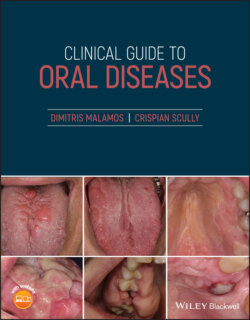Читать книгу Clinical Guide to Oral Diseases - Crispian Scully - Страница 16
Case 1.2
ОглавлениеFigure 1.2
CO: A six‐year‐old boy was admitted with bleeding of his mouth.
HPC: The patient sustained a facial injury during a football match half an hour before the bleeding.
PMH: He was a healthy child with no serious medical problems. He was very sociable, and used to take part in all activities at his kindergarten.
OE: He is a very young child, feeling stress and fear because of the bleeding in his mouth, especially from the area of deciduous central right incisor. This tooth had been pushed into its hemorrhagic and swollen gingivae (Figure 1.2). No other problems with the rest of his teeth, jaws, and oral mucosa were noticed.
Q1 What is the possible cause of the hemorrhage of this child?
1 Trauma
2 Self‐induced
3 Infections
4 Children abuse
5 Bleeding disorders
Answers:
1 Facial trauma is commonly noticed among children and characterized by soft tissue injuries (lips, oral mucosae, face) or deep ones into the maxilla or mandibular bone and their associated teeth. Facial trauma is responsible for the “impressive” bleeding due to the high vascularity of this area.
2 No
3 No
4 No
5 No
Comments: The absence of multiple bruises and hematomas alone, or with the different ages of lesions combined with the history of the accident and type of injuries in a child's body is an easy way to exclude bleeding disorders or child abuse from the diagnosis. The absence of fever, swelling and erythema in the lesion rules out infections (bacterial, viral, or fungal). In addition to this, the lack of similar lesions in the past together with the child's good healthy social life reinforces the idea that the lesion was not self‐induced.
Q2 Which is/are the difference(s) of facial trauma between children and adolescents?
1 Etiology
2 Bone involvement
3 Symptomatology
4 Complications
5 Recovery rate
Answers:
1 Facial trauma is caused by falling in children and by assault or altercation in adolescents.
2 Fractures of nose bones or jaws are more common in adolescents rather than in children.
3 The symptomatology in children does not fit with the severity of the lesions and is more remarkable than in adolescents.
4 The facial trauma in children is more superficial than in adolescents and their complications seem to be minimal.
5 The younger the children, the easier their recovery.
Q3 Which is the clinician's first priority when faced with a patient with facial injury?
1 Calm patient and his parents
2 Retain the airway open
3 Check for broken or dislocated teeth
4 Stop bleeding
5 Treat facial wound (cleaning and suturing)
Answers:
1 No
2 Retaining child's airway open is the first priority as the mucosal edema is disproportional with the patient's airway tract. The clinician should remove obstacles like debris, clots and foreign bodies from the oropharynx, control the location of patient's tongue while in severe cases an orotracheal intubation could be mandatory.
3 No
4 No
5 No
Comments: The second priority for the clinicians is to control bleeding by putting direct pressure on the facial injury. Having bleeding under control, clinicians are then able to properly examine the soft tissue injury, investigate for possible teeth and jaws fractures and then go further to cleanse and suture the wound, as well as reassuring the patient and his parents.
